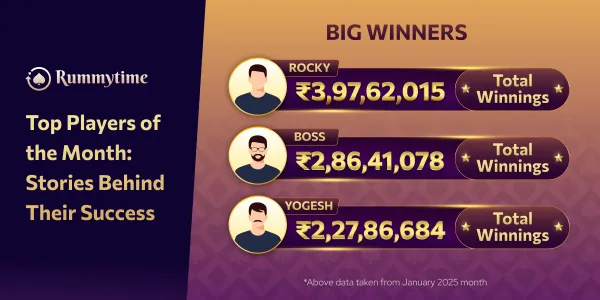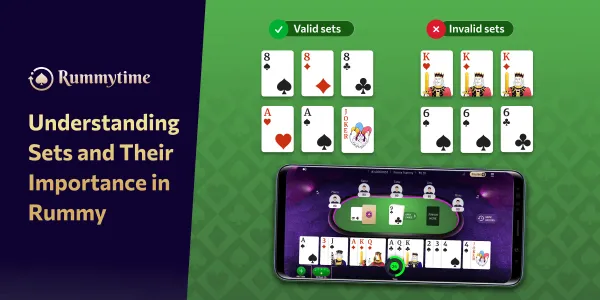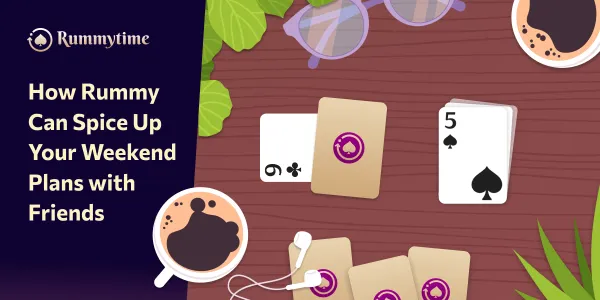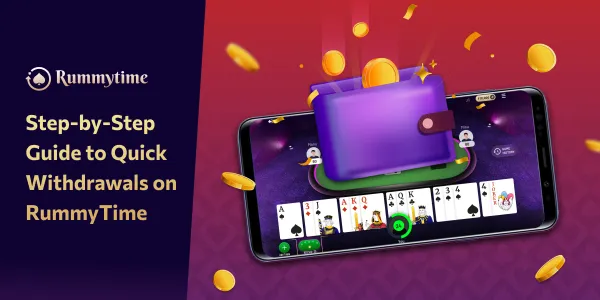- Home
- Social Buzz
- Traditional games of India: a look at popular card and board games
Traditional games of India: a look at popular card and board games
Board games and card games have always been a part of Indian life for over a thousand years with roots that trace back to ancient times. These games were not just a form of entertainment, but they were also embedded in our culture, history and even mythology.
RummyTime Elite Editors | 23rd May, 2025
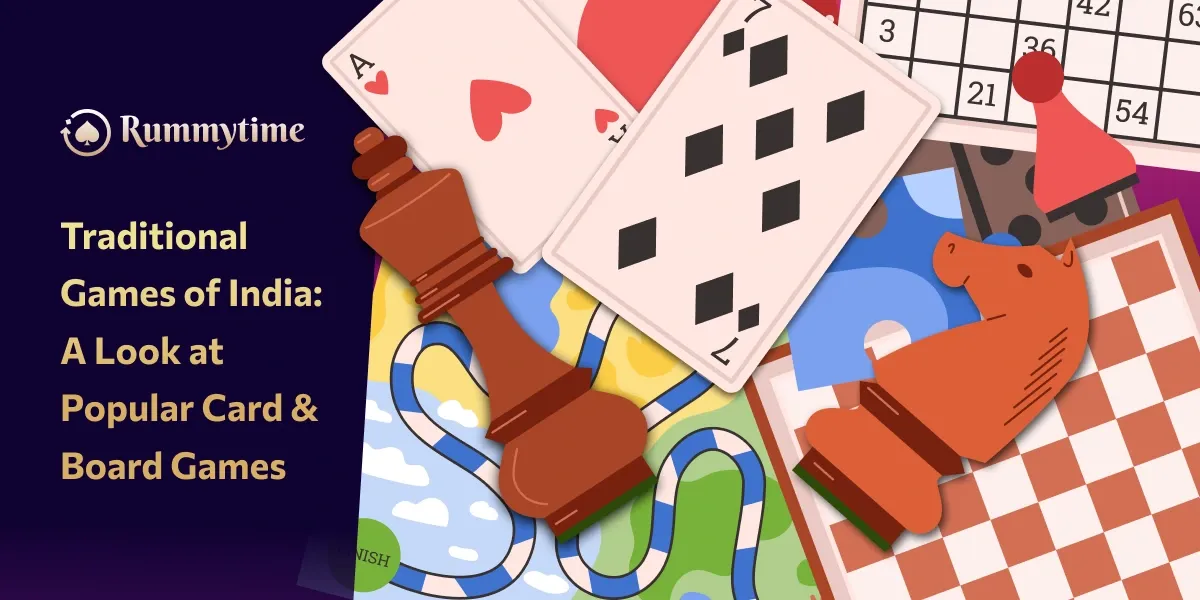
Traditional games of India
In a culture-rich country like India, board games hold a great significance even in history. If we take into consideration the epic – Mahabharat, you’ll notice how ‘Chaupar’ was often played by everyone in that era. While we shall dive deeper into it a little later, this blog is all about how India has always been a country of traditional games of cards and boards.
With emotions flowing in every Indian, bonds and interpersonal relationships become a big deal in our lives. What strengthens these bonds? Well, the popular card and board games! This way people didn’t just connect, they shared stories and passed down traditions creating strong bonds between different generations.
And so, the story continues. The spirit of these games live on. New age games like rummy have kept the sense of excitement and community still going in just a new form. It’s time to go down the memory lane and explore some of India’s most loved board and card games.
The legacy of traditional games in India
Board games and card games have always been a part of Indian life for over a thousand years with roots that trace back to ancient times. These games were not just a form of entertainment, but they were also embedded in our culture, history and even mythology. Like mentioned above, the earliest mentions of gaming can be found in Mahabharata, a dice game between Pandavas and Kauravas which is also a turning point in the epic
Summer breaks? Time to play cards! Family reunion during Vishu? Friends are staying the night? Well, you know there’s no way you’re getting out of that without a round of ludo. Indoor games, especially, have always held a special place in Indian households.
From simple games played with Cowrie to more complex board games like Monopoly, and Business, these pastimes brought families and communities together. They were often passed down through generations, played during gatherings, festivals, and quiet afternoons at home.
While these games have gotten adapted to the changing times and technologies. These board and card games are now also seen in digital versions reaching people across the country. But the intention behind all these games still remains the same – to bring people closer, encourage strategy and skill, and keep our cultural stories alive!
Popular Indian card games
Now that we know how all card games bring people together, how about we look at a few different card games popularly played in Indian households? We hope you get a few ideas on how these strategy-based Indian games have evolved with time.
Rummy – the most popular card game in India
Rummy is undoubtedly one of India’s most played games. Though its exact origin is still undecided, rummy gained popularity throughout the country during the early 20th century and has become a staple at get-togethers.
The game is all about forming valid sets and sequences. Rummy has a few popular variants that offer different styles of gameplay:
- Points Rummy – A fast-paced format where each card has a fixed point value. Players compete to win rounds quickly, and the winner gets points based on the cards left with the opponents.
- Pool Rummy – A longer version where players keep playing rounds until someone crosses a point limit (like 101 or 201). The last player remaining below the limit wins.
- Deals Rummy – Players are given a fixed number of deals (rounds). Each player starts with the same number of chips, and the one with the highest chip count at the end of all deals wins.
Basic Rummy Rules:
- Played with 2 to 6 players using one or two decks with jokers.
- Each player is dealt 13 cards.
- The goal is to form at least two sequences, out of which one must be a pure sequence (no joker).
- Remaining cards should be grouped into valid sequences or sets.
- A player must declare when they’ve successfully formed valid combinations.
With the rise of smartphones and apps, online Rummy has seen explosive growth. Platforms like RummyTime have made the game accessible to millions, bringing traditional fun into the digital age.
Explore more: How to play rummy
Ganjifa – the royal card game of India
Originally played in royal courts, the game had several versions based on themes like mythology and astrology. It involved a mix of strategy and luck, and was considered a game of the elite. Though not widely played today, Ganjifa remains a symbol of India’s artistic and gaming heritage as all the cards were always hand-painted.
Teen Patti – India’s own poker
Teen Patti, meaning “three cards,” is India’s homegrown version of poker. It’s especially popular during festivals like Diwali, where families and friends gather for long sessions of this thrilling game most commonly in Maharashtra, Gujarat, Delhi, and North India. Players are dealt three cards each, and the goal is to have the best hand or to bluff opponents into folding. Variations like Muflis, AK47, and Joker add fun twists to the basic gameplay.
Basic rules:
- Played with a standard 52-card deck (no jokers) by 3 to 6 players.
- Each player is dealt three face-down cards.
- The game starts with a boot amount (minimum stake) contributed by all players to the pot.
- Players can choose to play ‘Seen’ (look at their cards) or ‘Blind’ (without seeing their cards).
- Betting continues in turns, with each player either calling (matching the bet), raising (increasing the bet), or folding.
- The game ends in a showdown, where remaining players compare cards or when only one player is left after others fold.
Andar Bahar
Andar Bahar is believed to have originated in South India, particularly Karnataka. A single card is placed in the middle and the dealer alternates placing cards into two piles – andar and bahar – until the matching card appears. It is commonly played in Karnataka, Andhra Pradesh, and Telangana.
Basic rules:
- Played with a single 52-card deck.
- One card is drawn and placed face up in the center – this is called the joker or middle card.
- Players place bets on whether a matching card (same rank) will appear in the Andar (left) or Bahar (right) pile.
- The dealer then starts dealing cards alternately to the Andar and Bahar sides.
- The dealing continues until a card matching the joker’s rank appears.
- The side where the match appears is the winning side.
- Payouts are made based on which side was chosen and when the matching card appeared.
Teen Do Paanch
A staple in Punjab and Northern India, Teen Do Paanch is a 3-player trick-taking game using a 30-card modified deck. Players must win a set number of tricks: 3, 2, and 5 respectively. The winner in each round gets more cards and targets in the next, adding a role-switching element. Ultimately, to win this game your success depends on memory, hand management, and adapting strategy across rounds based on the number of cards dealt.
Basic rules:
- Played by 3 players using a 30-card deck (cards from 8 to Ace in each suit).
- Each player is assigned a trick target:
- Player 1 must win 3 tricks
- Player 2 must win 2 tricks
- Player 3 must win 5 tricks
- The player who meets or exceeds their target wins the round.
- In the next round, roles rotate based on performance:
- The player who won more tricks gets a higher target and is dealt more cards.
- The player with the lowest tricks gets fewer cards and a lower target.
- Players must follow suit during a trick; if they can’t, they may play any card.
- The highest card in the suit wins the trick.
- The game continues for multiple rounds with shifting roles and strategies.
Satte Pe Satta
Satte Pe Satta is a group-friendly card game that has been a favorite at family gatherings and festivals for generations. The game begins with the 7 of any suit, and players must build up or down in that suit while trying to shed all their cards. Simple in rules but engaging in play, it’s loved for its fast pace and inclusive nature. Popular across states like Uttar Pradesh, Bihar, and Rajasthan, Satte Pe Satta captures the spirit of community gaming – easy to learn, quick to play, and perfect for large groups.
Basic rules:
- Played with a standard 52-card deck.
- Best suited for 4 or more players, making it ideal for group play.
- The game starts with the 7 of any suit.
- Players take turns placing cards in ascending or descending order from the 7.
- Only cards of the same suit and in direct sequence can be played next.
- If a player cannot play a valid card, they pass their turn.
- The goal is to shed all your cards before the others.
- The first player to play all their cards wins the game.
Popular board games of India
India has given the world some of the most iconic boardgames that are loved by millions worldwide and also very famous throughout all age groups! Let us list a few games and talk about them in detail!
Pachisi – the royal game of India
Originating during the Mughal era, Pachisi was played on large cloth boards in royal courts. It later evolved into the now called Ludo with simpler rules and a square board.
Chess – India’s gift to the world
Chess, previously known as chaturanga, featured infantry, cavalry, elephants, and chariots. It’s a game of deep strategy and intelligence, challenging players to think several moves ahead. From India, it spread to the world becoming the global game we know today.
Ashtapada – the ancient strategy game
Played on an 8×8 unmarked board, Ashtapada was a strategy-based Indian game. It’s believed to have influenced the creation of Chaturanga – chess.
Snakes and Ladders – a moral teaching game
This game was created to teach karma and spiritual growth. Good deeds moved you up ladders while bad moves sent you down snakes. It was later adapted into the modern version now played worldwide.
Carrom
Carrom is a much-loved tabletop game that originated in India. Played on a smooth square board, the objective is to use a striker to pocket all your assigned coins – be it black or white before your opponent. The pink coin, known as the queen, holds the highest value and must be covered with another one of your coins immediately after being pocketed. While the rules are simple, Carrom is a game of high skill, demanding precision, finger control, and strategic planning. Whether played casually at home or competitively in clubs, Carrom remains one of India’s most iconic indoor games.
Here, you must have noticed that all these board and card games aren’t just skill or strategy based but also teach values and challenges the player to be a better human being in general.
Other traditional indoor games of India
Apart from card and board games, India is home to many such culturally rich indoor games that have stood the test of time. Gutte (Five stones) is a game of quick reflexes and hand-eye coordination. Pallankuzhi, popular in Tamil Nadu, involves strategic placement of cowries in a wooden board. Chowka Bara, a traditional dice game, shares similarities with Ludo and is known for its blend of luck and strategy. These games, simple yet engaging, continue to hold nostalgic value and reflect the diversity of India’s regional gaming traditions.
Why traditional games still matter today
Traditional games are more than just entertainment. They teach valuable life skills and help preserve culture.
Strategy, Patience, and Teamwork: Games like chess or kabaddi teach players to plan ahead, wait their turn, and work together. These skills are useful in everyday life and build discipline and cooperation.
Cultural Identity: Traditional games reflect local customs, stories, and values. They keep languages, rituals, and community spirit alive, especially in a globalized world.
Traditional Indian games are timeless treasure, blending fun with culture, and still connect generations through strategy and shared stories.
FAQs on traditional games of India
1. Which is the most famous traditional card game in India?
2. What are some other Indian strategy-based games other than rummy?
3. How is Pachisi different from Ludo?
4. Is chess originally from India?
5. Can I play traditional Indian games online?
Featured articles
